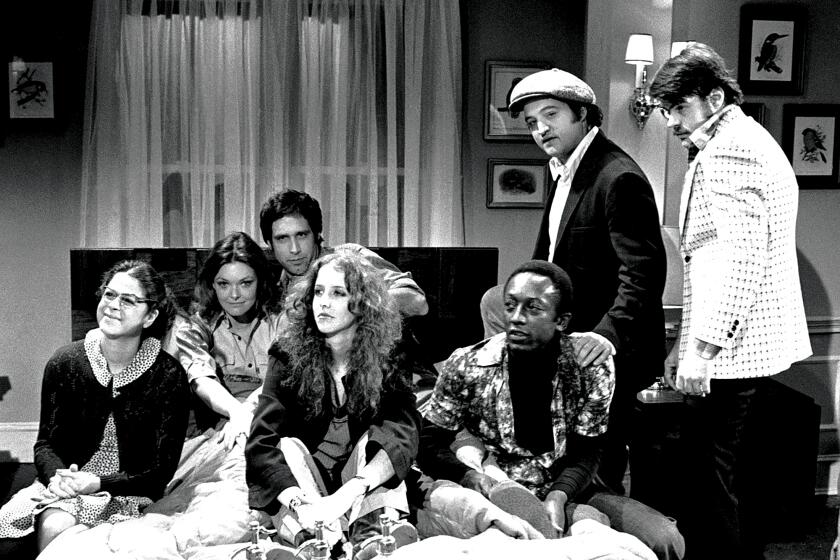Review: Visually rich ‘Samurai Jack’ is back in search of closure on Adult Swim
- Share via
Nearly 13 years after it ceased production, Genndy Tartakovsky’s animated epic “Samurai Jack” returns for a fifth season Saturday, to conclude its business.
Originally broadcast on Cartoon Network and now presented in the framework of its late-shift channel-mate, Adult Swim, the Emmy and Annie award-winning series was never really canceled; rather it fell by the wayside when Tartakovsky got busy making “Star Wars: Clone Wars.” (Not to be confused with the similarly titled, less wonderful 2008 CGI sequel.) At times it seemed set to return as a film but never did.
With Cal Arts classmate Craig McCracken, Tartakovsky was in the vanguard of a new age of television animation; McCracken worked on Tartakovsky’s “Dexter’ Laboratory,” the first full Cartoon Network series; Tartakovsky produced and directed episodes of McCracken’s “The Powerpuff Girls.” Cartoons have flourished wildly since then, in many varieties and variations — more or less sophisticated or primitive, experimental or old-school, family friendly or intended only for mature audiences (or for immature adult audiences). But there has been nothing quite like “Samurai Jack” in its dedication to making every frame a thing of beauty: Form here is content.
One might say that the series, which is set on a future Earth populated by aliens, mutants and machines — it’s a cousin in this respect to “Adventure Time” — more significantly takes place where the work of illustrator Charlie Harper and artist Katsushika Hokusai meets that of Disney artists Eyvind Earle and Mary Blair and filmmakers Akira Kurosawa, Sergio Leone and David Lean. It’s an aesthetic space, patterned and painterly, in which the third dimension is drawn, not mathematically plotted and computer-rendered. Tartakovsky plays with framing, using split-screen effects and letterboxing the image — and in the new series, pillarboxing it as well — for “cinematic” effects that also suggest the way a graphic novelist carves up a page.
Story has not been exactly beside the point, if only in that it determines what pictures we see. “Samurai Jack” tells tales of an ongoing battle between an evil, shape-shifting wizard, Aku (Greg Baldwin, replacing the late Mako), and the samurai Jack (Phil LaMarr) — he has cast into a far future where the wizard rules all. While roaming this world, defending himself and a variety of fantastic creatures from the Aku’s often mechanical enforcers, Jack seeks to return to his own time in order to defeat his nemesis and rewrite history.
Fifty years have passed since the end of the action in the original series, though Jack, through some trick of because-we-said-so, has not aged a day, only grown hairier. No longer the white-robed samurai of the original series, he’s become an unshaven, armored Road Warrior type, traveling the forests, plains, deserts and mountains on a weaponized motorbike. (What the bike runs on is not the kind of question you should be asking; it runs, basically, on fiction.) He has guns now, big ones.
In the original series, it was a given that neither Jack nor Aku would be permanently altered in any physical or moral or mental sense; the new season, inclining toward a conclusion, promises to be more plotted, less episodic, and though there is still room found for wacky cartoon silliness, the new venue — Adult Swim is specifically not for kids, though obviously kids will watch this — allows for a darker, edgier, marginally more violent cartoon.
Jack is tormented by thoughts of those he failed to save back in his own time and visited by a vision of his clean-shaven former self who seems to suggest he end it all: “There’s no more honor; come to think of it, the only honorable thing to do…” Aku, by contrast, arrives comically, wakened by an alarm clock, doing some creaky stretches, meeting his therapist. (“You see, doc, it’s been over 50 years already.” “Has it been that long?” “He hasn’t even aged … he just grew that stupid beard.”) Meanwhile, seven sister assassins have been raised from birth by Aku cultists to destroy Jack and win Aku’s favor.
Technological advances in animation and television itself have allowed for a “Samurai Jack” visually even richer than before — the canvas is wider, the images sharper. Everything glows. One hopes for a happy ending, of course, but what matters most is shape and color, the abstraction of rain on stone, the sun through the trees. It makes “Samurai Jack” endlessly rewatchable: Every picture tells a story.
‘Samurai Jack’
Where: Adult Swim (Cartoon Network)
When: 11 p.m. Saturday
Rating: TV-Y (suitable for young children)
Follow Robert Lloyd on Twitter @LATimesTVLloyd
ALSO
‘Adventure Time’ sets the series finale, but you still have time
Television review: ‘Clone’s’ new reality
The complete guide to home viewing
Get Screen Gab for everything about the TV shows and streaming movies everyone’s talking about.
You may occasionally receive promotional content from the Los Angeles Times.




